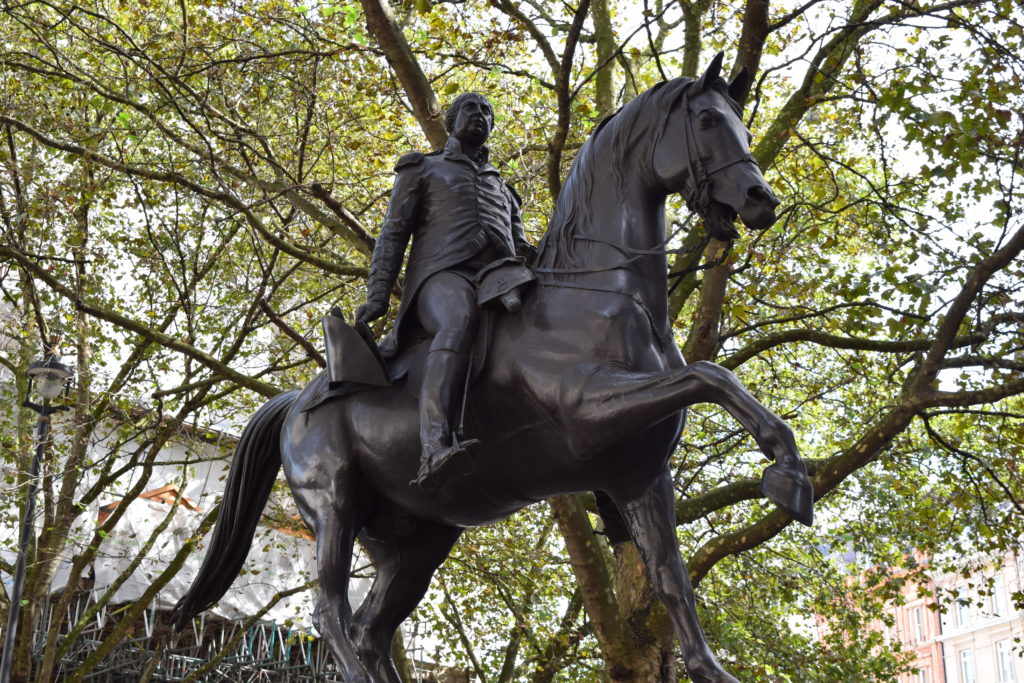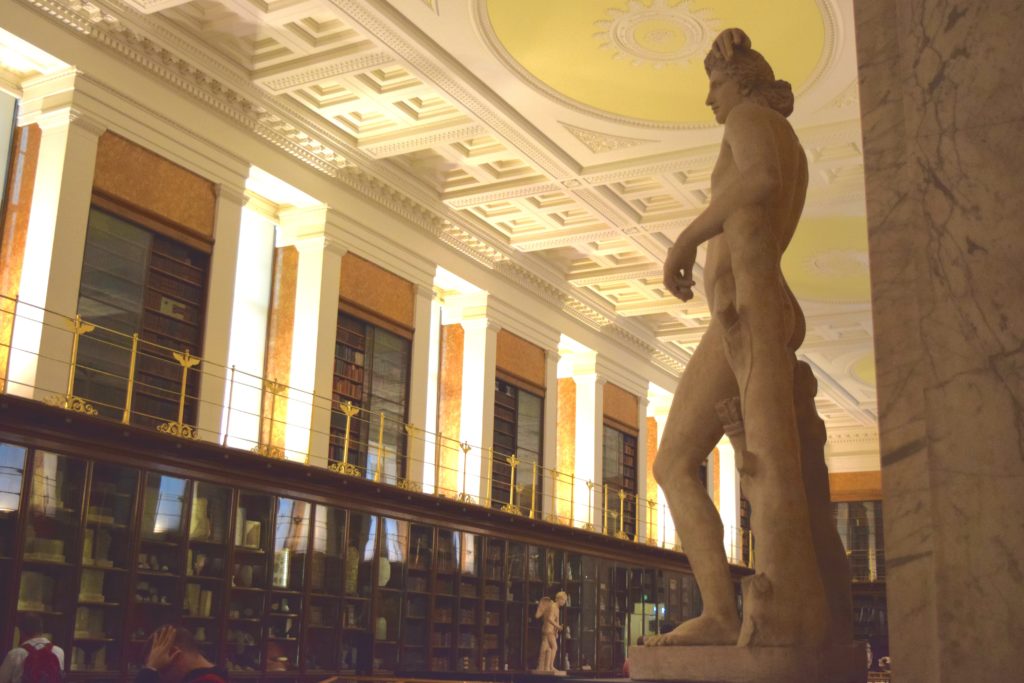
I have had a long respite from the challenges of maintaining an interesting blog, spending a goodly portion of time traveling to London and the surrounding countryside, storing up wonderful memories and visuals I cant wait to share with you. For an amateur historian like myself, the journey was a veritable feast. A city and country chocked full of the magnificence of 2500 years of people, places, and events that form so many of the cornerstones of western thought and civilization. But then, you knew that already. I will do my best to resist a tired litany of the stops that you can get from any travel guide or commemorative. Sometimes, unassuming things you note on your travels have a more profound effect upon you then the more illustrious sites. And certainly can make for more interesting writing.
For instance, I was struck by this beautiful statue of King George III under a pleasant tree on the east end of Pall Mall, the thoroughfare extending along St James Park, from St. James Street projecting towards Trafalgar Square. The statue, dedicated in 1836, sculpted by Matthew Coates Wyatt, is a magnificent equestrian statue showing a confident and intelligent sovereign aboard his powerful steed Adonis. One can certainly not say that the statue’s location is not situated among the most prominent street addresses in London. But as statues go, it is quite isolated from the nation’s most honored heroes, from Nelson soaring over Trafalgar Square to Prince George, Duke of Cambridge on Whitehall to the brooding Churchill gazing upon Parliament. The Boulevard of Whitehall the perfect scale for pageantry and prestige. And George III? Under a tree off of Pall Mall.
I’m sure I’m making too much of the statue’s location but it works into the psyche that the location is the subtle reference to this king having done something not associated with the other glamorous statuary subjects. George III lost some serious empire. And the nation memorialized the monarch in a respectful but not quite forgiving location.
George III ascended to the throne in 1760, and for the next 59 years served his nation with the longest reign of any male monarch in British history. By the time of his death in 1820, George III had presided over an epic period of history with both spectacular triumphs and ignominious defeats that have few equals in that nation’s annals. A descendant of the Hanover line of kings that had ruled Great Britain from 1714 to rescue the country from the succession crisis that resulted from the end of the House of Stuart as a provider of sovereigns. Despite being associated with German royalty, George III was a complete breath of fresh air when he first ascended the throne. This king was the first of the Hanoverian line born in England, proud of his englishness in speech, and a true son of the Enlightenment. He spoke multiple languages, was a religious and ethical man, immersed himself in science and other scholarly pursuits, and ruled the country with an eye on transforming the island nation into the most modern and powerful of nations on earth. Fortuitously in 1763, just three years into his reign, he stood astride a colossus that had just defeated its mortal enemy France in a world war, that resulted in England gaining a huge swath of the North American continent. The fragile english colonies on the eastern seaboard of North America could now look over two thousand miles of common language, law and commerce without the competition of a hostile French periphery. The new King could define himself as ruler of one of the great empires in human history.
Oh, to be King.
The problems started almost immediately with victory. The huge debt incurred in achieving the massive military victory had to be paid, and the King was not so enlightened when it came to the relationship of sovereign to subject. The Americans, who had gained security and spectacular opportunity with the expulsion of the French, were expected to help pay for their home country achieving such bounties for them. It would take the form initially of the Stamp Acts, means of deriving revenue from the Americans to help pay for the war that all had benefited from. Which takes us back to the Enlightenment, which brought new ideas from people like John Locke that influenced the American colonists to the point of confrontation with their king. Taxation without representation, however imprecise in the actual actions of the British parliament and king, was an intolerable act to the colonists. By 1775, the pressure cooker exploded into armed violence, and the king was faced with real insurrection. Kings and insurrection don’t go over well, and George III was not about to allow such affronts to his absolute authority.
How serious was the King? Ever so serious. Great Britain, so recently involved in worldwide conflict and stretched financially, determined through the will of its King to raise the largest amphibious force to that time assembled, and move over 35,000 fully trained and armed troops across the ocean to crush the rebellious colonists and their ragtag army. The idea that a set of colonies orders of magnitude larger than the homeland would be allowed to separate was absolute anathema.
Yet, in one of the truly amazing outcomes in history, the underdogs managed to beat their masters in an 8 year long struggle. The King was forced to release through treaty millions of square miles of the North American continent so soon after previous triumph. The humiliation so great, King George III was willing to abdicate as a testimonial to his acceptance of his role in the debacle. That’s how you end up under a tree in an obscure corner of a park.
But the saga and pathos of course don’t end there. Under George III’s rule, the loss of portions of North America propelled a sequence of events that culminated in the overthrow of the monarchy in France, the very real danger of an invading republican army from France, and progressively the crisis propagated by the rise of a military genius dictator on the continent named Napoleon Bonaparte that threatened the very existence of the monarchy. True to form, King George III once again marshaled his forces, and under the epic triumphant heroism of Horatio Nelson at Trafalgar and the Duke of Wellington at Waterloo, Great Britain reigned supreme. Guess where their statues ended up.
Crushing Louis XV and gaining half a continent. Crushing Napoleon and gaining an empire. One might see a good reason to place poor King George III more among the pantheon of national heroes. But losing to Americans, that just proved undigestible. King George III steadily buffeted against mental illness, and by the time of the triumph of Waterloo, was in no position to reorient people’s opinions.
The record would suggest one of Britain’s more substantial monarchs, and the peerless gift he made to the nation of a library befitting of an enlightened world power is still seen today in the masterful library of King George III in the British museum.
As an American, I am certainly glad that King George III was the rigid foil upon which a great nation was able to birth and overcome. But a little bit sympathy and respect is in order to someone who on the basis of one loss has seen forever tainted his role in his nation’s greatness.
I’m not saying move the statue, but maybe when you’re in a rush to see all the other paeans to winners, remember old George didn’t do so bad himself.
e
